Jays Stores was a store in Lower Road, Rotherhithe, that had a large sign advertising Jays for Jeans at the top of the building, above an illustration of a man presumably dressed in clothes available from the store.
My father photographed Jays Stores and the Jays for Jeans sign in 1986:

I could not get exactly the same view as in 1986 due to road works occupying the space directly opposite, however an almost the same view of Jays for Jeans, 38 years later in January 2024:
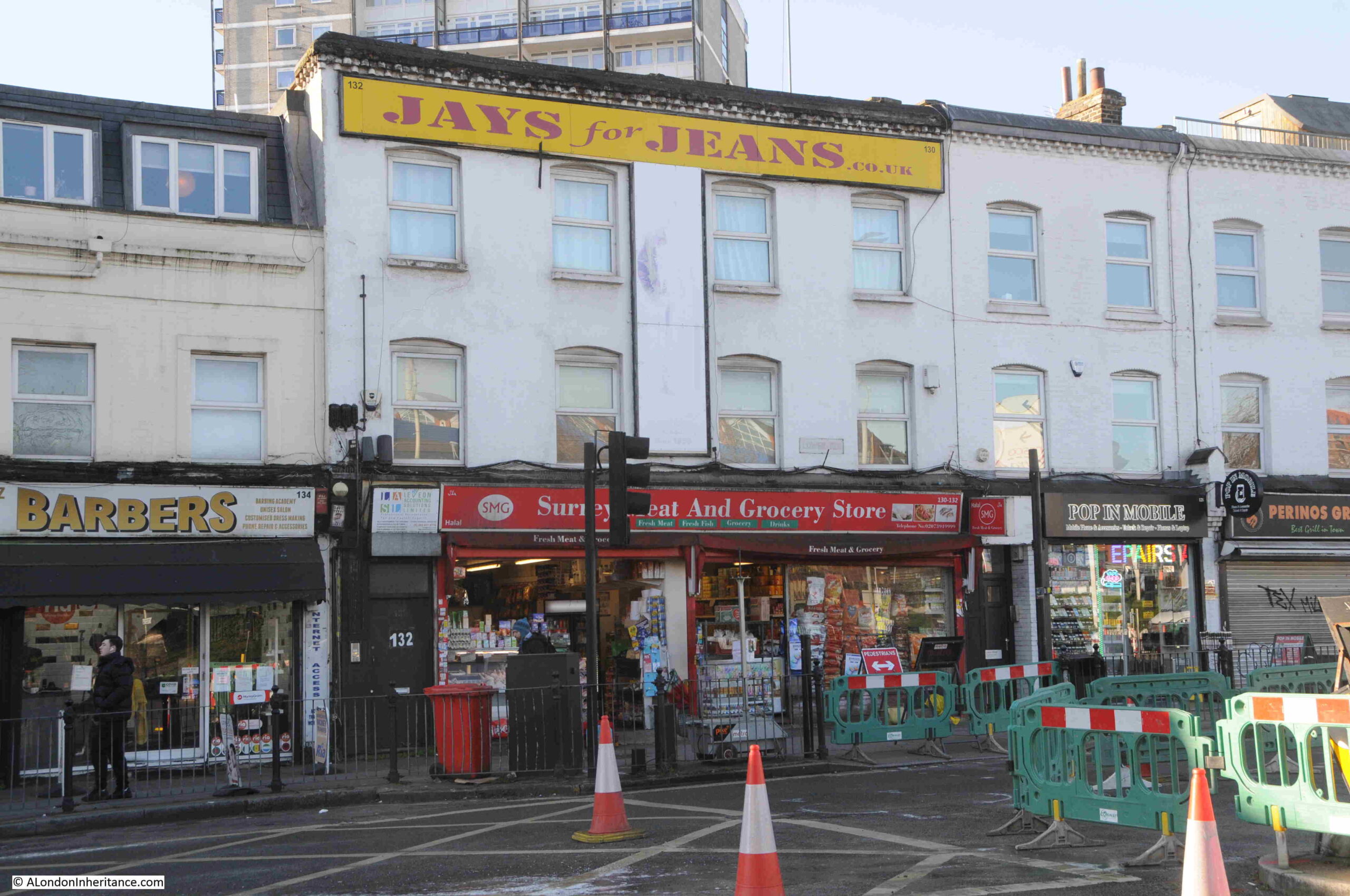
I am not sure exactly when Jays Stores opened, but the store closed in 2016. I suspect that the location of the store opposite the shops of the Surrey Quays shopping centre, Internet shopping, and the loss of local industry, with the resulting loss of trade for industrial wear, donkey jackets etc. (as advertised in the 1986 window) resulted in the store being economically unviable.
The store did make it onto the Internet though, as the surviving sign on the top of the building in 2024 shows that Jays for Jeans had a.co.uk address for the store, a different sign to the one in 1986.
The central panel has either completely faded, or perhaps been over painted.
To the right of the store, in the 1986 photo, can be seen part of one of the estate agents set-up to market the new properties being built as part of the redevelopment of the docklands.
Jays for Jeans is one of those local landmarks that defines an area for a specific period of time.
I walked down to the location of Jays for Jeans from Canada Water station, having arrived on the Jubilee Line.
It was a short walk, by the most direct route (that avoided the Surrey Quays shopping centre), but a route that confirmed that you can find things of interest in almost any London street, and is one of the joys of walking.
The following map shows my route from Canada Water station (within the red circle) down to the site of Jays for Jeans, next to the Surrey Quays station which is over ground only (dark blue circle). the dark blue dotted line shows the short route (© OpenStreetMap contributors):
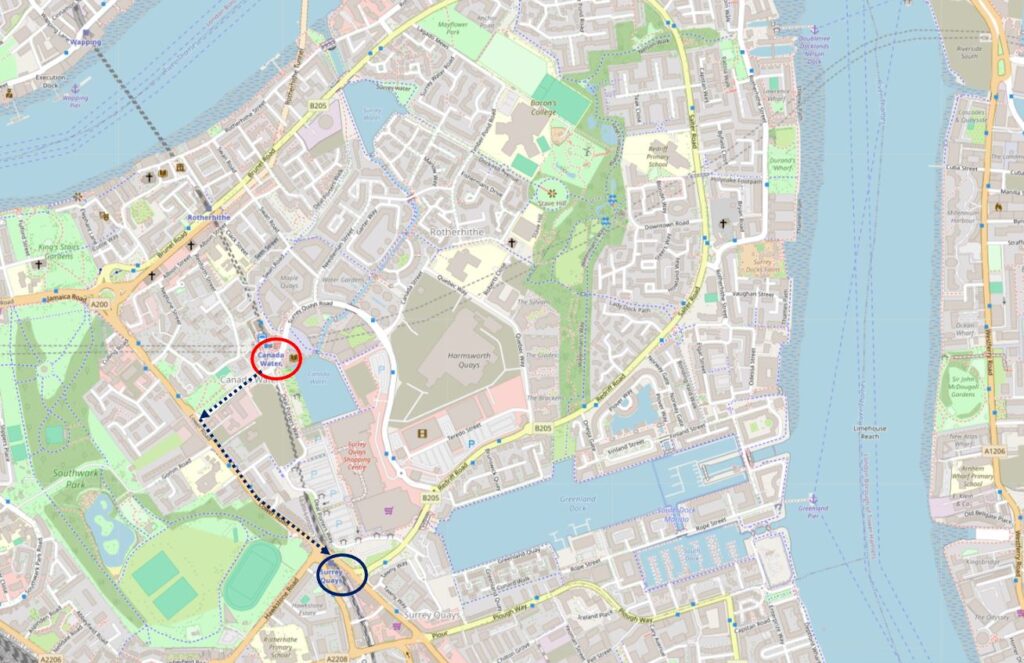
Staring with the wonderful drum structure over Canada Water station, a design which allows a large amount of natural light to get into the station below. The drum is above the escalators which run between the ticket hall and the platforms below:
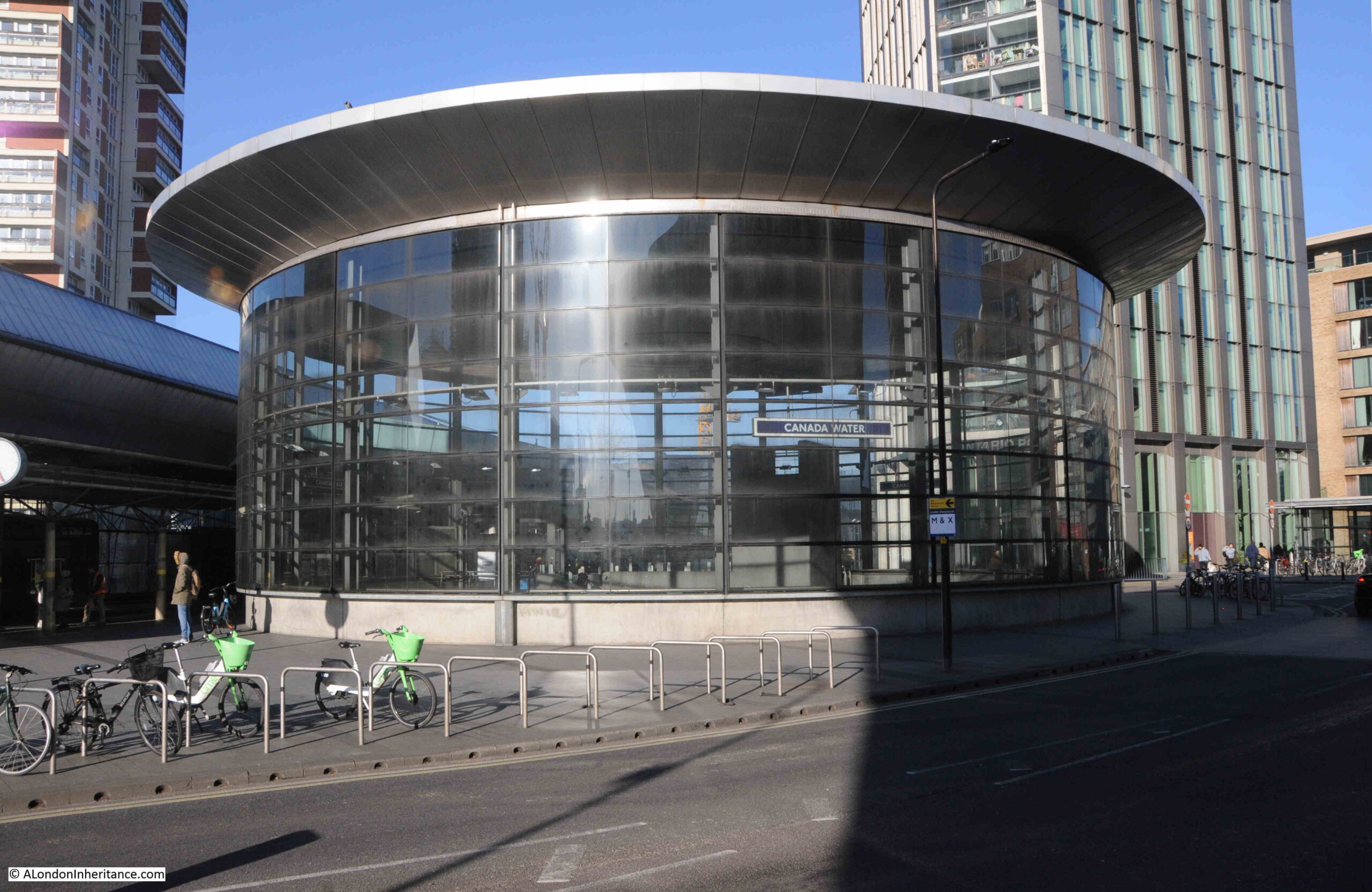
From Canada Water Station, I headed down Surrey Quays Road, a street which was one of the main entrances into the Surrey Commercial Docks which once occupied the majority of this part of Rotherhithe.
Along this street is one of the very few remaining buildings from the docks – the Dock Manager’s Offices:

This glorious buildings is Grade II listed, and dates from 1892 when it was built by the Surrey Commercial Dock Company.
The building is very well preserved, and when in use as the dock offices, it consisted of three main parts: the Superintendent’s Office with clock tower, a Janitor’s House, which is the smaller block closest to the camera with the Dock Offices signage, and a large open plan General Office, which can be seen in the above photo receding to the right.

The building is now owned by British Land, and I believe part of the interior has been designed to showcase the flats that are being built as part of the significant redevelopment going on around the Surrey Quays area.
There is a plaque on the side of the Dock Manager’s Office which records a major event during the last war:

I am going to save the story of the docks here in Rotherhithe for some later posts as there is so much to tell about this part of London, and for now, I will continue on to Jays for Jeans.
At the end of Surrey Quays Road, the street meets Lower Road, and on the western side of Lower Road is the Seven Islands Leisure Centre:

Opened as the Rotherhithe Bath and Assembly Hall on the 27th of November, 1965, the building included a swimming pool, assembly hall with stage and dressing rooms, crèche and play area for children and a place for sunbathing.
The name comes from what were believed to have been seven islands in-between the streams that drained Rotherhithe and Bermondsey into the Thames.
The building retains a wonderful example of the coat of arms of the old Metropolitan Borough of Bermondsey:

Bermondsey, as a Metropolitan Borough existed from 1900 (when it brought together the old parishes of Bermondsey, Rotherhithe and St. Olave), until 1965 when it was replaced by the London Borough of Southwark.
Within the coat of arms, the lion and the two letter B’s on either side, are from the Bermondsey Vestry and have their origins in Bermondsey Abbey.
The crown and the axe are from St. Olave, and come from the Royal Arms of Norway (see this post for more details on the origins of St. Olave and the connection with Norway).
Rotherhithe and the docks are represented by the ship at bottom right.
The Latin motto at the bottom of the arms, “prosunt gentibus artes” means “Arts profit the people”
On the opposite side of Lower Road is a brick built block of apartments, with a blue plaque between the first and second floors, above the central arch:

The blue plaque is to King Edward Frederick Muteesa II, the first President of Uganda:

Muteesa was the Kabaka (king or ruler) of Buganda, one of the individual kingdoms that make up the country of Uganda.
When Uganda became independent from Britain in 1962, Milton Obote became the Federal Prime Minister, and Obote negotiated an agreement with Muteesa that he would become President of Uganda, an agreement which was implemented by secret vote in Parliament on the 4th of October, 1963.
In the following years, there was infighting between the coalition that made up Parliament and between Obote and Muteesa, and it finally got to the point where in February 1966, Obote suspended the Federal Constitution and declared himself President, thereby deposing Muteesa.
Muteesa fled into exile and arrived in London, penniless, and without any support from the Government of Uganda.
During his earlier years he had been educated at Cambridge, where he also joined the university’s officer training corps, which led to a commission as a Captain in the Grenadier Guards.
It was this military connection that was to help with accommodation in London, and an old military contact provided him with the apartment in Orchard House, Lower Road.
He was not there for too long as on the 21st of November, 1969, he was found dead in the apartment, apparently of alcohol poisoning. A few hours before his death he had been interviewed by the BBC correspondent John Simpson, who found him sober, and there have been theories that he was murdered.
He was temporarily buried in England until the political situation changed in Uganda when Idi Amin overthrew Milton Obote and Muteesa’s body was returned to Uganda and given a state funeral and burial.
As with so much of London, there are a number of closed pubs in Lower Road, places that recall the working class history of the area.
The first of these is the Prince of Orange:

The pub seems to have opened around the late 1830s / 1840s as it is during these years that I find the first mentions of what appears to be the Prince of Orange pub.
In the following decades there are all the usual mentions of events that you would expect to find in a London pub in the docks, with crime, fights, jobs available etc.
in the pubs last few decades, it seems to have been a venue for jazz, as in newspapers there are plenty of adverts, such as for Pete Boulter’s Blues Jam session (1995), and Mr. B Plays Basie (1983). In the Stage and Television Today in October 1982, it was reported that “on the pub front, let us applaud the Prince of Wales, Buckhurst Hill and the Prince of Orange, Rotherhithe, both presenting jazz practically every night of the week”.
At times, the pub was on BBC Radio 2, for example the listings for the 25th of January, 1988, included “Jazz Score, where Benny Green is in the chair at the Prince of Orange, Rotherhithe, and on the panel are Acker Bilk, Peter Clayton, Alan Elsdon and Ronnie Scott”.
The Prince of Orange is now apartments.
A short distance further along Lower Road is another closed pub, the China Hall:
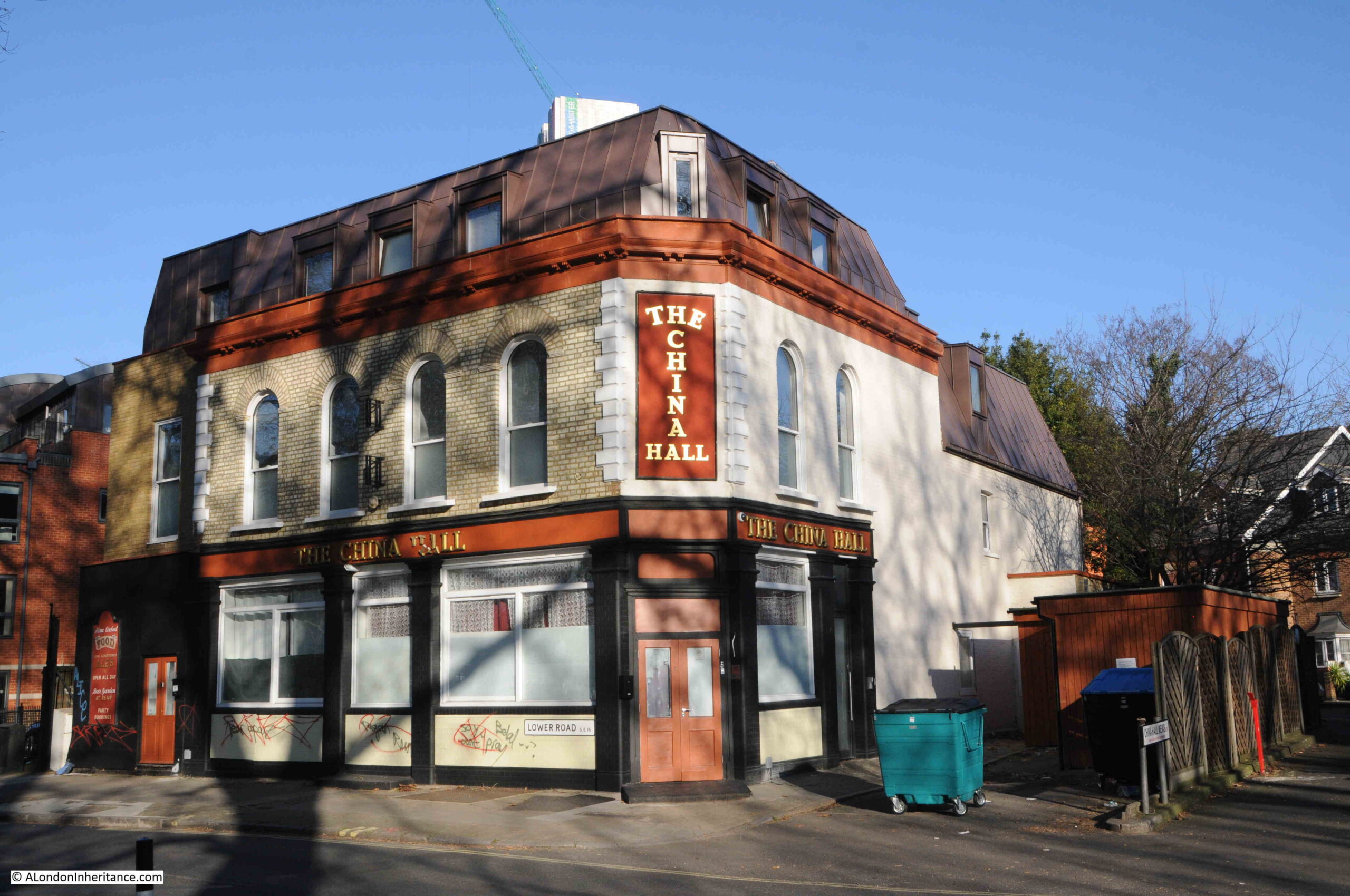
There has been a pub on the site for a number of centuries and in 1719 a pub on the site was apparently called the “Cock and Pye Ale House.”
The earliest written reference I can find to the name China Hall is in the Oracle and Daily Advertiser, on the 27th of February, 1802, when “A few afternoons since, about half past four o’clock,, as Mr. Witts of the Europa Inn, Rotherhithe, was travelling near China Hall, in the lower Deptford Road, he was stopped by a single foot-pad, who robbed him of a £2 note and his cash”.
The road was originally called Lower Deptford Road, but has since dropped Deptford and is now simply Lower Road.
The site of the pub has a long history. In 1776 the pub appears to have been leased to a trader in tea and china called Jonathan Oldfield, and who built a theatre next to the pub, called the China Hall. The name may have come from his trade in china, and the name appears to have transferred from the theatre to the pub.
Edward Walford, writing in Old and New London (1878), has the following to say about the China Hall: “In former times a narrow pathway, called the ‘Halfpenny Hatch’ extended through the meadows and market-gardens from Blue Anchor Road to the Deptford Lower Road, where it emerged close by an old and much-frequented public-house called the ‘China Hall’. The ancient tavern, which was a picturesque building partly surrounded by an external gallery, was pulled down within the last few years, and in its place has been erected a more modern-looking tavern, bearing the same sign.
Our old friend Pepys mentions going to China Hall, but gives us no further particulars. It is not unlikely, says Mr. Larwood in his History of Signboards, that this was the same place which, in the summer of 1777, was opened as a theatre. Whatever its use in former times, it was at that time a warehouse of a paper manufacturer.
In those days the West End often visited the entertainments of the East, and the new theatre was sufficiently patronised to enable the proprietors to venture upon some embellishments. The prices were – boxes 3s; pit 2s, gallery 1s; and the time of commencement varied from half-past six to seven o’clock, according to the season. The Wonder, Love in a Village, the Comical Courtship and the Lying Valet were among the plays performed. The famous Cooke was one of the actors in the season of 1778. In that same year the building suffered the usual fate of theaters, and was utterly destroyed by fire”.
The China Hall pub closed at the end of 2018, after a local campaign failed to save it, although it appears to have been a going concern, was wanted by the local community and had publicans who wanted to continue.
The ownership of the pub has been very controversial, and since closure the upper floors have been converted to residential, with extra space from the addition of a mansard roof.
The ground floor did appear to be undergoing conversion however council planners issued a warning notice to stop. A planning application was made for conversion of the ground floor, this was turned down, and the council issued an enforcement notice requiring removal of residential partitions and fixtures.
The owner has since appealed against the planning refusal – I do not know the status of this appeal.
The China Hall illustrates the sad fate of many London pubs, that even when they are still viable businesses, and wanted by the local community, they are all too easily sold to a developer who can find more profit in the conversion of the property to residential.
Continuing down Lower Road, and on the eastern side of the street is a row of late 19th century, terrace houses. The second house on the left has a plaque to Ada Salter, just above the ground floor bay window, directly above where green bins can be seen:

Ada Brown was born in 1866, a child within a Wesleyan Methodist family in Raunds, Northamptonshire. She moved to London in 1896, where she joined the West London Mission of the Wesleyan Sisters of the People, before moving to their Bermondsey Settlement in 1897.
Alfred Salter was a student at Guy’s Hospital when he met Ada at the Bermondsey Settlement. They married in 1900 and lived in Bermondsey. Both Ada and Alfred worked tirelessly to improve conditions in Bermondsey and Rotherhithe.
The house with the plaque is at 149 Lower Road, and was the Women’s House of the Bermondsey Settlement. Ada lived in the house for two periods in 1897 and 1898.
The plaque is very recent as it was installed on the house in 2023:
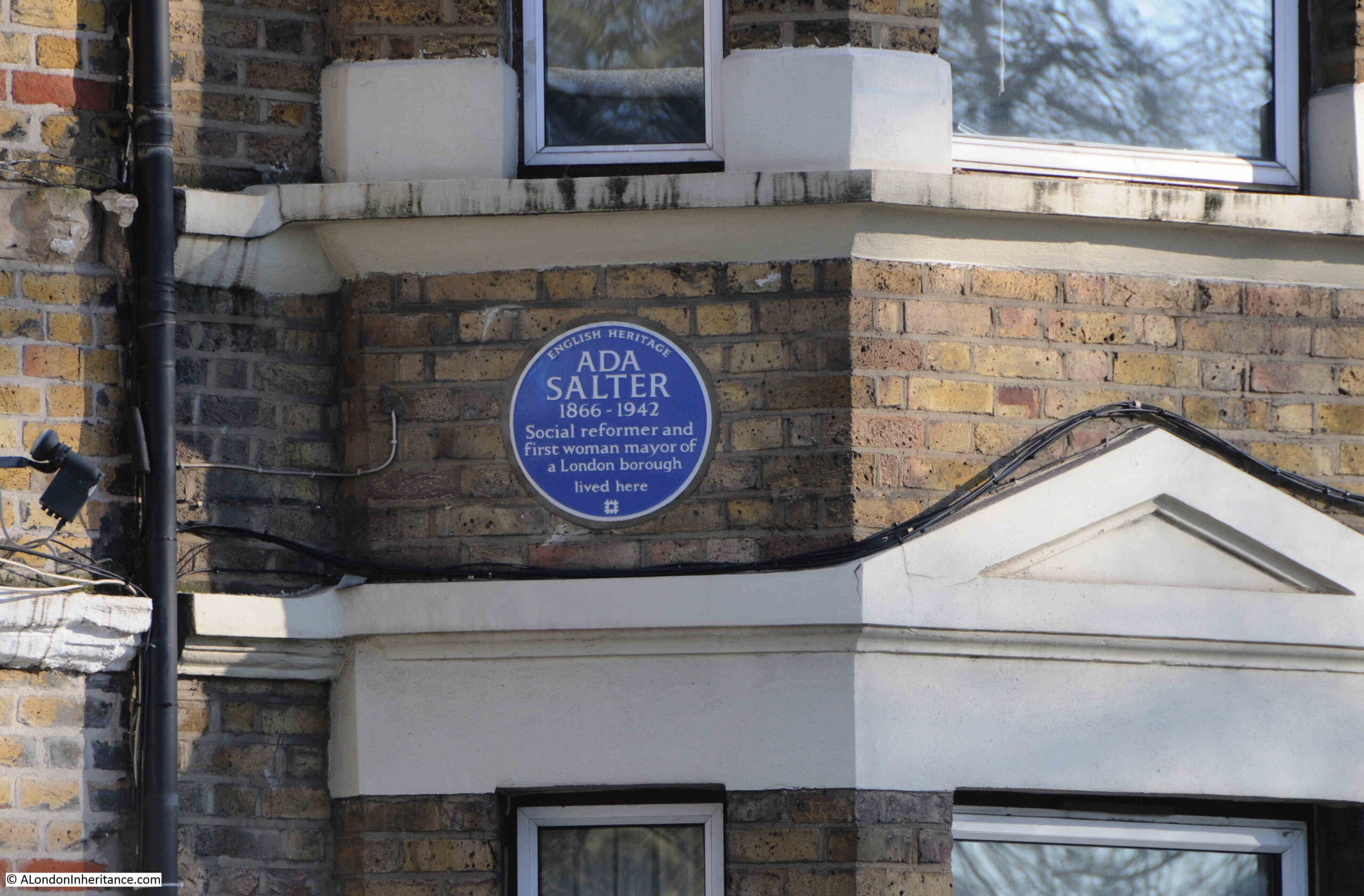
Ada became a Labour councilor, the first woman councilor in Bermondsey in 1909 and set about recruiting women workers to trade unions to organise against the terrible working conditions in the area’s factories.
Alfred was elected MP for Bermondsey in 1909, the same year as Ada was elected Mayor.
A view of Ada’s campaigning approach to improving the living conditions of Londoner’s, can be seen in the following first two sections from an article she wrote in the Daily Herald on the 28th of February, 1934, titled: “Don’t forget the HIDDEN LONDON”:
“London is the most wonderful and romantic city in the world. London leads. What London thinks to-day Great Britain will do to-morrow.
Underlying its romance, its magnificence, its power, its wealth and its resources, is a vast morass of sorrow and misery, of poverty and struggle, of unrequited toil and unmerited suffering.
Watch some hundreds of thousands of citizens pouring each evening out of their office and work places in the centre of London and follow them to their homes. You will have glimpses of drab, featureless streets, rows of Early Victorian terrace houses, huge blocks of tenement dwellings. In these industrial dormitories the workers are not housed, but warehoused. Observe the daily fight for tram or bus and all the discomfort that it involves. Note the imperfect education given to children, too large classes, insufficiency of secondary schools, inadequacy of playing space in all working-class quarters.
Compare the dullness and ugliness of grace and colour which constitute the environment of the poor with the stateliness and magnificence of the West End and the pleasing amenities of the middle-class suburb.
Contrast the narrow, shut-in back yards with the spacious gardens surrounding the houses of the well-to-do. Remember the acres and acres of playing fields attached to all the public schools of England where the sons of the rich are educated, and then turn to the cramped, asphalted play grounds of the elementary schools in Bermondsey, Southwark, Bethnal Green, Stepney and Poplar.
It is this London of the mean streets to which our thoughts should turn at a London County Council Election rather than the ‘show’ London which visitors from the country and abroad come to see.”
Ada Salter in the early 1920s:
Ada was also featured in “The VOTE -THE ORGAN OF THE WOMEN’S FREEDOM LEAGUE” on the 1st of December 1922, when she was the fifth in a series of features on women mayors. In the article, she wrote:
“As the first woman in London to be offered the position of Mayor, I am proud that I live and work in a borough, the elected representatives of which are prepared to choose an individual who belongs to what is sometimes described as the weaker sex. As a woman, I am naturally eager that the woman’s share in responsibility of government should be a direct one. There is still a tremendous leeway to be made up in all departments of life that affect women, but the failure to catch the vision of a free humanity, where men and women can act together, and not in antagonism, is not confirmed to one sex.
By common consent, the Bermondsey Borough Council has for some years dispensed with the wearing of the Mayoral and Aldermanic robes, but I also do not intend to wear the chain of office. This, of course, is a purely personal matter. For brilliant colouring, and for the brightness of gold, I have the greatest admiration, but I desire them not as symbols of place and power. The ideal for which we must strive is to secure respect for the authority and decisions of the Chair, rather by personality and character, than by decorations of office.”
I suspect we need more Ada’s in politics today.
Ada Salter died on the 4th of December, 1942. One of the newspaper reports of her death started with “The death of Mrs. Ada Salter, who was London’s first woman Mayor, is a reminder of the many hitherto exclusively masculine fields in which women have now staked out a claim”.
Continuing down to the site of Jays for Jeans, and the third pub in this short walk. This is still open as a bar and restaurant but with a new name of the Yellow House:
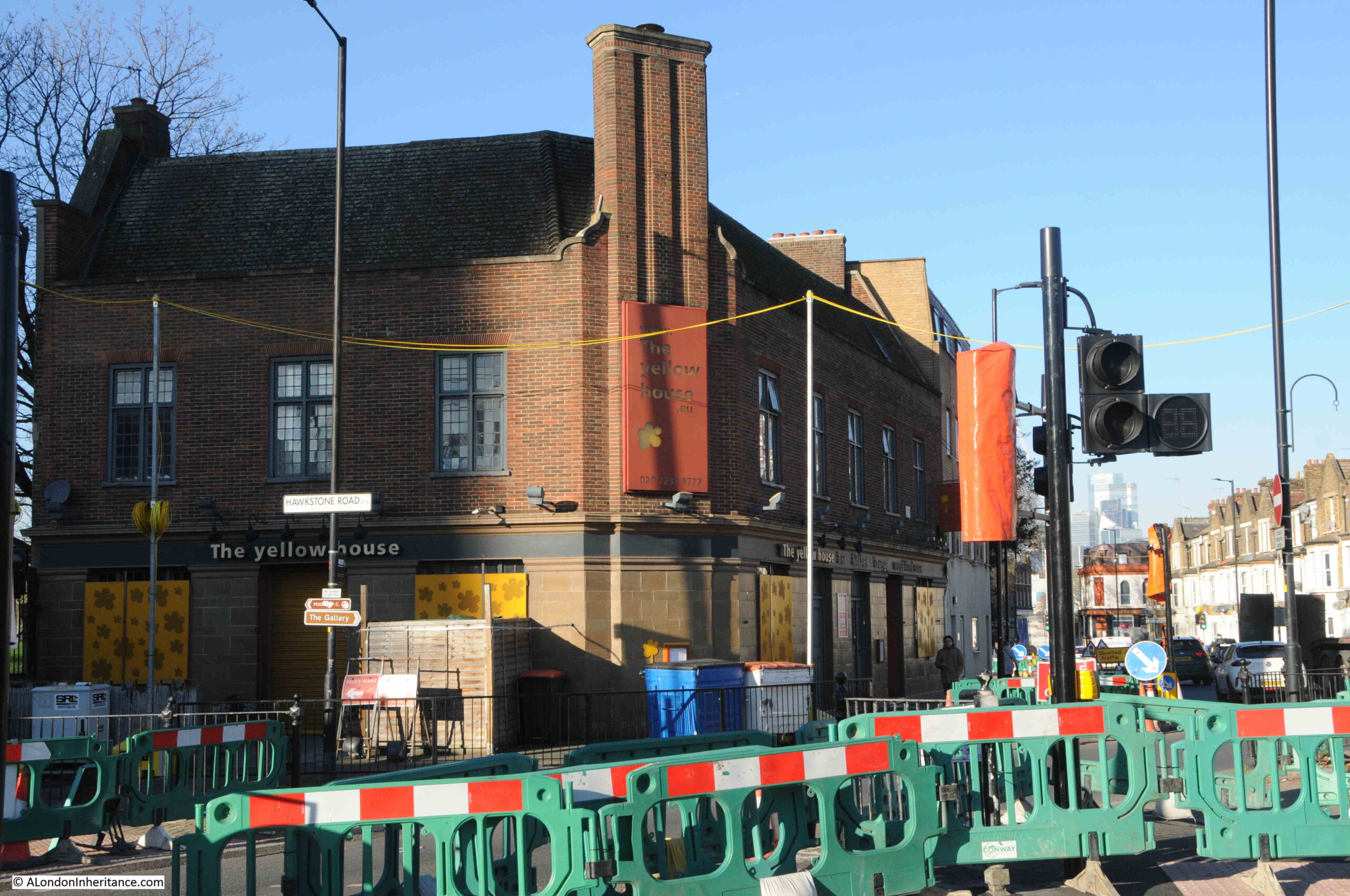
The was the Caulkers, originally the Jolly Caulkers, and in a couple of references, the Merry Caulkers.
A Caulker was the person who had the job to fill in any gaps in a ship, to make it watertight. Filling the gaps between originally wooden planks and later the metal sheets that would make up the hull of a ship.
A profession that would have been found across the docks of Rotherhithe.
The earliest reference I can find to the pub is in the 1840s, however the design of the pub does not look 19th century, and I suspect it may have been rebuilt in the 1910s, as in the South London Gazette in 1919 there are references to the New Jolly Caulkers, and which therefore may be a reference to the pub we see today.
And a very short distance on from the Yellow House / Caulkers, was Jays for Jeans.
A short walk, which has revealed one of the few remaining buildings from the time when Rotherhithe was covered in docks, the coat of arms of the Metropolitan Borough of Bermondsey, the first President of Uganda, Ada Salter, a campaigner for the living conditions of London’s working class and London’s first woman mayor, and three historic pubs.
There is so much more to write about this area, and the large dock complex that once occupied much of this part of Rotherhithe, and I hope to return in future posts.

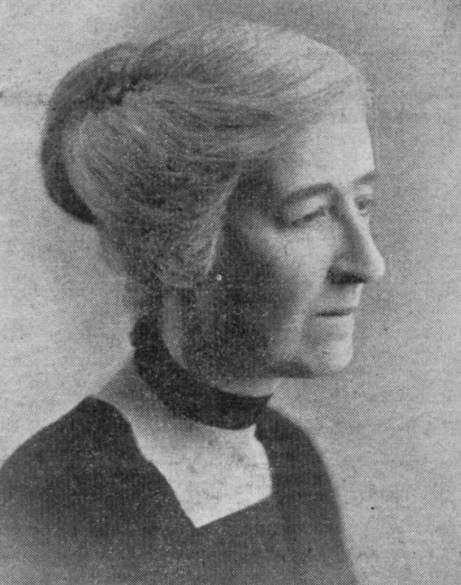
This is wonderful, informative, and exciting information for us because this is literally our shopping route and we pass through Surrey Keys, pas the Jays for Jeans sign every time! Thank you!
An interesting and informative post, as always. Thank you very much.
ItI is such an interesting area, looking forward to reading more.
Thanks for the morning walk! If only the press would report on the more interesting people and areas. Or maybe the bygone holds more charm. I think McVities had a big biscuit making factory in Bermondsey. The early factories were quite paternalistic and dentists and other services provided with whole families and generational employment. Those were the days when true artists were employed in advertising.
Be kinder to the local press. There is an article here https://southlondon.co.uk/area/southwark/the-jean-genies-bermondsey/
Published only last year, with more history about Jay’s and complimentary to this always interesting blog
Peak Freans biscuits factory. Loved the smell of the biscuits baking
Very interesting, thank you.
I was there only this week as a friend lives in Brunswick Quay.
Another interesting building is the now deconsecrated Swedish church next to the prince of orange pub. Very ornate bronze doors are still in place.
Seem to remember these landmarks on the route of the 188 bus from Russell Square to the Cutty Sark and the Greenwich Peninsula, one of the most delightful cross town routes…if it still runs.
188 still going strong. Caught it the other day from Greenwich to Bermondsey.
Yes the 188 still runs and it is a handy route if there are Jubilee line problems or you just prefer the bus or need to get somewhere a bit further in from the river. I sometimes use it for Holborn – takes longer than Tube but you get to see everywhere and don’t have to change!
Oh it still runs and is a wonderful route – we take it to go shopping every week!
Heavens above! I remember buying a grey fisherman’s anorak there when I was 14, 61 years ago. That was a fascinating shop. It was the “go to” place for out of the ordinary clothes. It was known for miles around and at the time was one of the few places that sold such stuff.
Keep up the good work.
It is your attention to detail that makes this blog so good.
The Jolly Caulkers had a football team – and quite a good one too – and when my team, Old Olavians, (another story) played them in a cup game in the late 60’s their many supporters had poles with lots of crown beer bottle tops nailed into them, which they banged on the ground to make a very singular loud jingling noise – and very intimidating it was too!
Kent had the equivalent of Jay’s in a small chain called Baldocks that operated out of West Malling. Their idea of window display hadn’t evolved from it’s Victorian roots and it’s stock in trade was hard wearing clothes and boots with a sideline in ski wear. The chain slowly faded away and the last shop in West Malling about 2018 with passing of the last Baldock. Really was a foot in a past world.
I remember Danny Baker telling a story of the man behind the counter in Jays deliberately spilling a drop of coffee on the counter then, jokingly, taking his wig off to wipe up the mess!
Fascinating as always. I was immediately reminded of the old Bell public house on Lambeth Road when looking at the Jolly Caulkers. I wonder if they shared an architect…. It’s a style I find very very attractive.
Well it’s never too late to be educated, thank you for this informative post about an area of London I’ve never visited and a fascinating and historically important woman, Ada Salter, I’d never heard of.
Doesn’t surprise me that she came from a Methodist family as the Methodist was one of the few UK religious groups who were involved in the trade union movement, education and health improvements for the urban working class..
Lavender Hill, Battersea. Was still there in 1999, not sure how much longer.
https://www.flickr.com/photos/petermarshall/50255529837/in/album-72157715589148871/
Across the Road from Jays Jeans is a restored shelter where in old days, men hoping for a day’s docker work would gather in the morning. It was very dependent on what ships arrived that day.
One of the reasons of the amount of devastation of the Surrey Docks was that they specialised in the Import of Timber. Hence the numerous references to Canada and the Nordic countries in the vicinity.
Edward Jenners pioneering research & trials of vaccine is associated with farm in the area.
Michael Caine’s birthplace St.Olave’s is nearby.
The London Overground passes under Tesco’s car park and the tunnel walls show bomb damage repairs.
Remnants of the Surrey Canal can be seen at Greenland Dock.
The very tall brickwork walls between Surrey Quays Station and Tesco’s Car Park today are a remnant of the outer walls of the Docks estate. No doubt to discourage theft.
Not sure if is still the case, but The London Marathon runners used to turn right at Jays to head around Redcliffe Road.
Interesting as ever. Thank you!
I was fascinated by the part that read, “. . . who robbed him of a £2 note and his cash”.
A two pound note? I’ve Googled it and found nothing. So I wonder what it was
? An IOU?
I used the Lavender Hill branch of Jays for many years. It closed in the early 2000s and I then went to Rotherhithe. I’m still occasionally wearing a pair of Levis 501s they sold me. They also sold me, from Rotherhithe in 2006, a superb foul weather jacket that makes any form of inclement weather irrelevant. It’s as good as new and I last wore it yesterday.
A great shop and I wish it was still in business. I think trading ceased as the chaps who ran it wanted to retire.
Superb ways takes everything worth remembering back in day the great article on rotherhithe l will remember this post have a good day you got good taste don’t forget Millwall round the Corner . .
If you are around the area of Canada Water, a visit to the Museum of London Docklands is worthwhile. See their permanent exhibitions on the Blitz and Sailortown. It is housed in one of the 2 giant warehouses in West India Dock which survived the Blitz: https://www.museumoflondon.org.uk/museum-london-docklands/permanent-galleries
Ada Salter and her husband are represented by some very touching bronze statues on the Southbank….
maybe you know them? They are looking at a little girl….their daughter who died, It’s called “Dr Salter’s Daydream” .Here is the link https://livinglondonhistory.com › dr-salters-daydream-a-very-moving-set-of-statues.
I was really pleased to see you writing about her in your last post…she seems to have been a wonderful person. She belonged to the same West London Methodist Mission as my great great aunt, who ran creches for very poor working mothers and theirchildren in the Kingsway area: Sister Hope’s creches.
Another interesting post. I used to drive down Lower Road a lot in the 1990s, but not much since the Millennium. However look forward to future posts on the area as my son has just moved to a house share just off Brunel Road. I can recall that the Design Museum was for a few years in a building near Rotherhithe station.
Great!
Yes a lovely posting. Jays is missed as I used to go there specially to buy Solovair shoes, the antecedents of DMs. The shop guys knew their stuff. Anther local point of interest is the birthplace of Michael Caine.
Another brilliantly informative piece! Yes, indeed, we need more people like Ada Salter in local and national politics!
Ada is our local heroine!
I used to live in the top floor flat whose windows you see under that sign! Between 1994 & 1996. As others have pointed out there was another branch in Battersea. The owner & my landlord was Martin Jay who owned a couple of other properties along Lower Road
Wonderful article, thank you! Reminded me of Dickie Dirts on North End Road in Fulham. The only place in the early 1970s I could get mens’ Levi 501s with a 26 inch waist! Needless to say that’s not my current size…